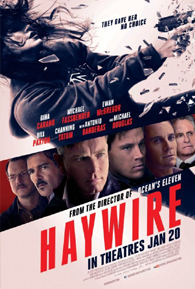
The story is simple – a former Marine freelancing as an assassin and human transporter is framed in an overseas mission that went wrong and is now out to clear her name, discover where the web of treachery leads, and exact a bloody and painful revenge. But writer Lem Dobbs, taking a page from Tarrantino's Kill Bill films, starts the story in media res and tells the tale out of order in a series of globetrotting flashbacks taking place in Spain, France, Ireland, and ending in America – with each flashback ending with a fight sequence where Carano executes a co-star.
The narrative stylistics allow Soderbergh to show off his penchant for montage and his skill for technical directing. Though the tale is set in the modern day, Soderbergh makes a strong effort to recreate the casual violence, amorality, and gritty look of 70s US action flicks which in their day were influenced by Jean-Pierre Melville, another great visual stylist.
What works in Haywire is Gina Carano in her athletic celebration of action heroines. Strangely enough, what doesn't quite work at times is Soderbergh's direction. Opting for muffled gunfire and near silence, Soderbergh's very technical direction has the effect here of sapping a set piece of its vitality, an action scene of its danger and tension.
That said, Haywire is a good martial arts action film and offers a very rare action heroine in Western film. It's not quite near Tarrantino fun but the story will have Tarrantino eating his heart out.












 打印版本
打印版本











读者回应
抢先发表第一个回应吧!
请先登入再使用此功能。